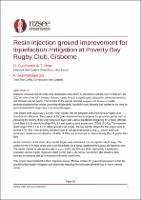Resin Injection ground improvement for liquefaction mitigation at Poverty Bay Rugby Club, Gisborne

Download
Date
2024-04-09Authors
Gunchenko, Daniel
Giannakogiorgos, Andreas
Hnat, Theo
Metadata
Show full item recordAbstract
Gisborne is located near the Hikurangi Subduction Zone which contributes to a significant amount of the seismic activity in New Zealand. This coupled with Gisborne’s soil profile consisting of liquefiable sands has resulted in the need for ground improvement for larger structures across the region.
This project used Resin Injection for ground improvement at the Poverty Bay Rugby Club Grandstand in Gisborne. The purpose was liquefaction mitigation at ULS for the seismic loading of Mw 6.4 and a peak ground acceleration (PGA) of 0.41g. The improvement depth ranged from 1.5 - 4.2 m below ground level. The key specific targets for this project were to achieve 67% NBS (IL3) with an average improvement of qc1N,cs of 30%, and an increase in relative density (Dr) of greater than 60%.
At the conclusion of the works, all key specific targets were achieved across the injection depth range. The works met the 67% NBS target with an average non-liquefiable crust being established throughout the injection zone. The results showed an average increase in qc1N,cs by 33% and achieved an average Dr of 66%. Liquefaction analysis of the CRR and CSR also showed a 68% increase and 16% decrease respectively. This would suggest that there would be a reduction in future earthquake demand/load on this site.
This project demonstrated that Resin Injection is an effective method for ground improvement at this site, providing liquefaction mitigation and potentially reducing the earthquake demand/load in future seismic events.
